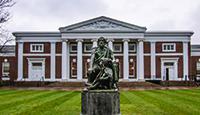
As a historian of art and the British empire, Douglas Fordham is interested in a wide array of visual art from the seventeenth century to the present in the Anglophone world. He is a co-editor with Tim Barringer and Geoff Quilley of Art and the British Empire (Manchester University Press, 2007), which helped to place empire at the center of the study of British art. His first monograph, British Art and the Seven Years' War: Allegiance and Autonomy (University of Pennsylvania Press, 2010) examined the relationship of imperial politics to artistic organization in London in the mid-eighteenth century. His second monograph, Aquatint Worlds: Travel, Print, and Empire (Yale University Press, 2019) considered how the newly discovered medium of aquatint printmaking conditioned the representation and reception of the world beyond Europe in the late eighteenth and early nineteenth centuries. The book takes a particularly close look at the representation of the cave temples of western India, the indigenous and white settler communities of southern Africa, and the Macartney expedition to Qing China. Artists in each of these locations returned to London to collaborate with a team of printmakers, hand-colorists, booksellers, and distributors to produce some of the most beautiful and innovative picture books of the modern era.
Respondent: Tom Young joined the University of Warwick in late 2020 as a Leverhulme Trust Early Career Fellow at the History of Art Department. Tom’s current research is centred on two projects. The first explores the global history of lithography, with the ambition of writing a book called Lithography and the Modern World. Lithography’s global impact has never previously been charted, despite the technology enabling the first truly international decentralisation of mass media. The book will chart how the technology’s invention catalysed dramatic cultural and political upheavals across the globe, giving rise to modern ideas and institutions. His second project is a book called British Art in India’s ‘Age of Reform’, c.1813–58. This project developed from his PhD research, which examined a collection of previously unstudied prints, drawings, and paintings produced in nineteenth-century India. The book uses these materials to present a new interpretation of the East India Company’s nationalisation. Challenging the established idea that British Parliament brought a ‘rogue’ corporation to heel, it argues instead that a revolution in the artistic worlds of colonial society worked to destabilise the Company’s political legitimacy—supporting the growth of middle classes with alternative ideas about how India should be governed, and undermining Anglo-India’s idiosyncratic politics by better connecting the cultural worlds of the British empire.

